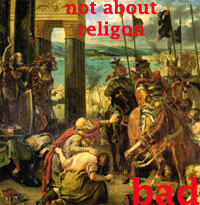Period 3:Regional and Transregional Interaction: 600 C.E. To 1450
In this period, some major changes happened. These changes would shape the world as we know it today. Religously, a new player was on the rise: Islam, and one of the big players - Christianity- underwent a split, known as the Great Schisim. Politically, Europe was feudal, the Byzantine were still central, and Islamic caliphates were on the rise.
Religon in the Post-Classical Period
Islam, a monotheisitic religon much like Christianity and Judaisim, started to rise. The religon started with the words of the Prophet Muhammad that he heard from their God Allah. The followers of Islam are called Muslims. Their holy city is Mecca and also Medina. A big standpoint in Islam is the Five Pillars of Faith. They are:
1. Shahadah: There is no God except for Allah (God) and his prophet is Muhammad.
2. Salat: ritual prayer five times a day
3. Sawm: fasting and self-control during the blessed month of Ramadan
4.Zakat: giving 2.5% of one’s savings to the poor and needy
5. Hajj: pilgrimage to Mecca at least once in a lifetime
Islam is split into two parts at this time, known as: Sunni and Shia. The Sunni believe that the religous leader ( who also tends to be the political leader ) shouldn't have to be a direct disendant of Muhammad. The Shia believe that he should, because that's how it had worked before. It's also important to note that Islam bore no ill will towards Christians or Jews because they were children of the book and merely worshiped a different version of Allah.
